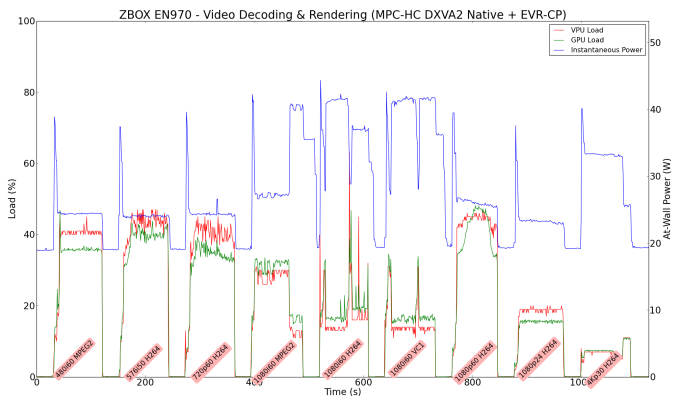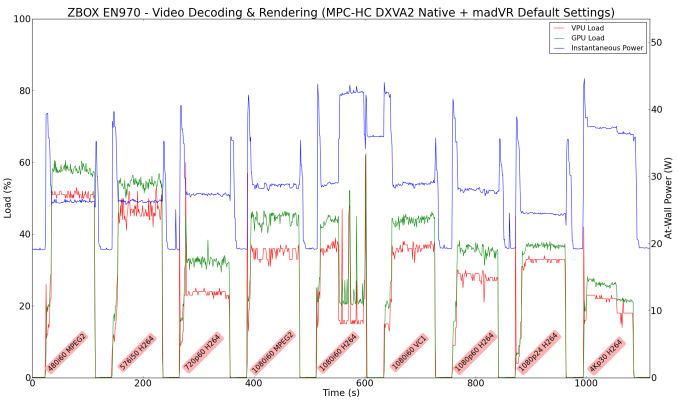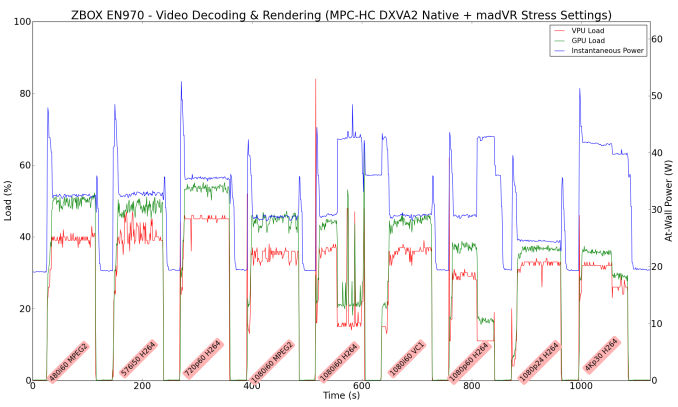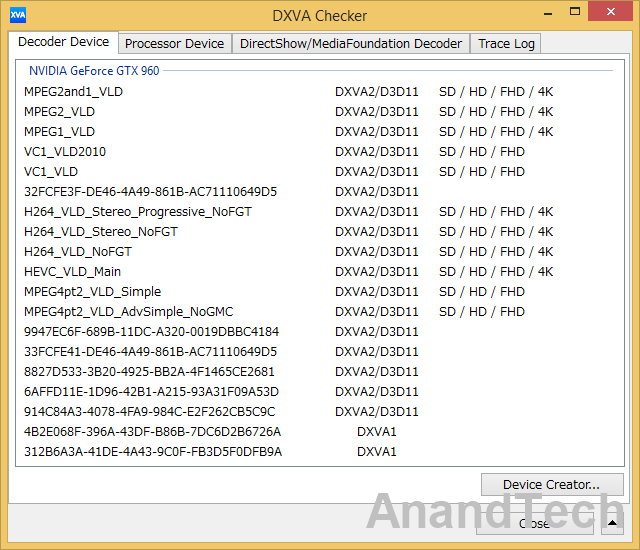Zotac ZBOX MAGNUS EN970 Review - A Gaming mini-PC Done Right
by Ganesh T S on September 28, 2015 8:00 AM ESTHTPC Credentials
Despite being actively cooled, I was pleasantly surprised by the noise profile of the system. The fans have variable rotational speeds, and in general, for most media related activities, the fan noise is minimal. I would go as far to say that the noise is probably the lowest amongst all the gaming mini-PCs that we have evaluated.
Refresh Rate Accurancy
Starting with Haswell, Intel, AMD and NVIDIA have been on par with respect to display refresh rate accuracy. The most important refresh rate for videophiles is obviously 23.976 Hz (the 23 Hz setting). The Zotac ZBOX MAGNUS EN970 does not have the same out-of-the-box accuracy possessed by Intel and AMD. However, NVIDIA also allows for setting custom resolutions and refresh rates.
The gallery below presents some of the other refresh rates that we tested out. The first statistic in madVR's OSD indicates the display refresh rate.
Network Streaming Efficiency
Evaluation of OTT playback efficiency was done by playing back our standard YouTube test stream and five minutes from our standard Netflix test title. Using HTML5, the YouTube stream plays back a 720p encoding. Since YouTube now defaults to HTML5 for video playback, we have stopped evaluating Adobe Flash acceleration. Note that only NVIDIA exposes GPU and VPU loads separately. Both Intel and AMD bundle the decoder load along with the GPU load. The following two graphs show the power consumption at the wall for playback of the HTML5 stream in Mozilla Firefox (v 41.0).

GPU load and VPU load were around 16.01% and 21.42% for the YouTube HTML5 stream.GPU load in the steady state for the Netflix streaming case was 5.88% and the VPU load was 4.36%.
Netflix streaming evaluation was done using the Windows 8.1 Netflix app. Manual stream selection is available (Ctrl-Alt-Shift-S) and debug information / statistics can also be viewed (Ctrl-Alt-Shift-D). Statistics collected for the YouTube streaming experiment were also collected here.

Decoding and Rendering Benchmarks
In order to evaluate local file playback, we concentrate on EVR-CP and madVR. We already know that EVR works quite well even with the Intel IGP for our test streams.
In our earlier reviews, we focused on presenting the GPU loading and power consumption at the wall in a table (with problematic streams in bold). Starting with the Broadwell NUC review, we decided to represent the GPU load and power consumption in a graph with dual Y-axes. Nine different test streams of 90 seconds each were played back with a gap of 30 seconds between each of them. The characteristics of each stream are annotated at the bottom of the graph. Note that the GPU usage is graphed in red and needs to be considered against the left axis, while the at-wall power consumption is graphed in green and needs to be considered against the right axis.
Frame drops are evident whenever the GPU load consistently stays above the 85 - 90% mark. An important aspect to note here for NVIDIA GPUs is that the load reported doesn't take into account the GPU clock. For example, the 4Kp30 clip in the EVR-CP mode: Initially, the GPU and VPU operate at higher clocks, resulting in the reported load being 7 - 8% and the power consumption being around 34W. However, later on towards the end of the stream, the load jumps up to around 12%, but the power consumption is now only around 25 W. Essentially, the power consumption at the wall is the real metric of efficiency for decode and playback. As long as the GPU load stays below the 85 - 90% mark, frame drops don't occur.
EVR-CP and madVR Defaults don't present any challenges to the GTX 960
Since the GTX 960 is a powerful GPU, we evaluated madVR with both default and stress settings. The 'madVR stress settings' was configured with the upscaling algorithms set to Jinc 3-tap with anti-ringing activated and the downscaling algorithm set to Lanczos 3-tap, again with anti-ringing activated.
The ZBOX MAGNUS EN970 was able to handle the madVR stress configuration without any issues.
Moving on to codec support, the GTX 970M / GM204 is a known quantity with regards to the scope of supported hardware accelerated codecs.
There is no HEVC_VLD_Main10 support. This is a bit disappointing since the real desktop GTX 960 supports Main10 decoding in hardware. Other than that aspect, the ZBOX MAGNUS EN970 actually makes for a reasonably power-efficient madVR-capable HTPC.


















88 Comments
View All Comments
Teknobug - Tuesday, September 29, 2015 - link
How is the Alpha's i3 4130T slower than a mobile i5 5200U? i3 2.9Ghz vs i5 2.2-2.7GHz and i3 having a slighly faster IPC which matters for games.meacupla - Tuesday, September 29, 2015 - link
I think he said that the GTX 860M was slower than the GTX970M.For gaming purposes, GPU > CPU
smorebuds - Tuesday, September 29, 2015 - link
I guess it depends on what you value more from your living room gaming device... i3-4130T is a bit faster, but also uses more than twice the power, meaning it'll need bigger/noisier fans and a bigger enclosure.Teknobug - Monday, September 28, 2015 - link
The CPU and GPU combination doesn't really make sense here.barleyguy - Monday, September 28, 2015 - link
For the thermal constraints it makes perfect sense. Zotac had an i7 ZBox, but it had the fan noise of a jet engine. For 1080p gaming in a small quiet box, the lower power i5 and GeForce 970m is a good choice IMO.boe - Monday, September 28, 2015 - link
I'd love to see something in this general design but optimized for home theater - no fans - big heat radiators if necessary, HDMI 2.0a well suited for 4K, DTS-X and Dobly Atmos. I'm not terribly concerned about gaming.angrypatm - Monday, September 28, 2015 - link
Audio is always overlooked by manufacturers and reviewers. Power consumption, short of a high end gaming rig that sucks power like a refrigerator, seems irrelevant to me. Example; does anyone really take power consumption int account when buying a tv? "This one has a better picture but that one uses less power, so we'll take the more energy efficient model." --?!boe - Monday, September 28, 2015 - link
Is there any way to get the writers to consider an article on HT PCs? I think building HT servers is pretty standard but building quiet HTPC to play the streamed media can be expensive as the cases I've found can run up to $1500. Technically the entire HTPC could probably be done for about $450 but I haven't found anything that really is SILENT, and has HDMI 2.0a, and supports high end audio. Doesn't mean they don't exist, I'm just not sure who makes them.DanNeely - Monday, September 28, 2015 - link
Anandtech does review a lot of HTPCs. If you're looking for a DIY build guide, they seem to be very infrequent even for general use systems (vs sites like Arstechnica doing them yearly). A general build your own guide might be interesting; but I wonder if this wouldn't be a better subject for a future Build-a-Rig competition.http://www.anandtech.com/tag/htpc
SpartyOn - Monday, September 28, 2015 - link
I built a Steam streaming PC/HTPC with this embedded solution which seems to fit your requirements: http://www.asrock.com/mb/Intel/N3700-ITX/Just put it in a fanless chassis or a really good box with a silent fan and you're good to go. Doesn't meet your high-end audio requirement per se, but there is an open x1 slot for adding whatever audio solution is needed.
I've been rocking this for the last month and a half and it's been a great game and video streamer (though I'm not doing 4K output - don't have a 4K TV).
I think I paid $200 for the parts (board & CPU, 8GB ram, 64GB SSD, case w/ incl. PSU).